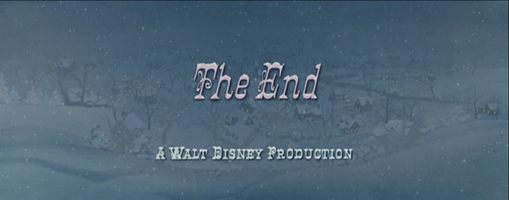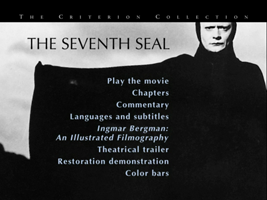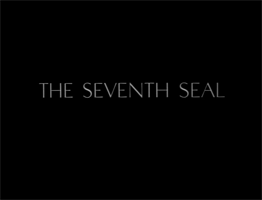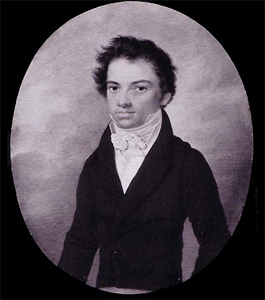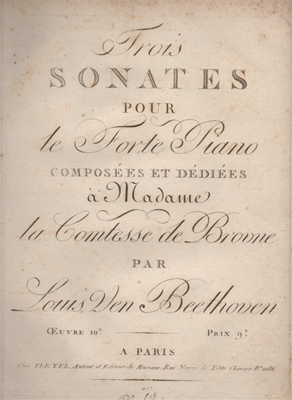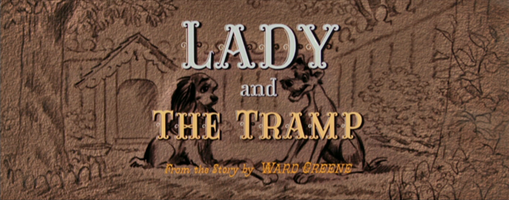
ADAM I didn’t realize that dogs were so ethnic. I think in the fifties, white people’s ethnicity must have been one of the paramount facts about them to other white people, and it’s weird that that was such a staple source of humor.
BROOM You mean the different breeds of dogs? Or the fact that on Monday Tramp goes to the German house, on Tuesday to the Irish house, on Wednesday he goes to the Italian restaurant…
ADAM All of it. Basically all of the characters other than Lady and her owners are characterized exclusively by their ethnicity.
BROOM No. I disagree with that.
ADAM Not everyone, but virtually everyone.
BROOM I disagree with the “exclusively.” The characterizations in the pound were not just ethnic types, They were characterized within ethnic types.
ADAM But they’re stereotypes based on ethnic types. The Russian guy is a crazy philosopher…
BROOM Yes, he’s one of several Russian stereotypes. He’s a particular Russian stereotype. He’s not just “Russian.”
ADAM The Scottie is sort of proud and miserly.
BROOM He didn’t actually have miserly characteristics, did he?
ADAM The first thing you see is him hoarding bones.
BROOM Oh yeah. And singing “Loch Lomond” with lyrics about bones. But Old Trusty wasn’t just an ethnic type.
ADAM Well, “southern” is sort of a stand-in ethnicity.
BROOM Yes, those were elements in their characterizations. But the characterizations were thoroughly worked out for each of these characters. There was the floozy…
ADAM The “lovable slattern.” I liked her. She was one of my favorite characters. She was the floozy with a heart of gold.
BROOM She was Goldie Hawn, as Beth said.
ADAM She was probably the nicest dog, and I thought her face had the most personality.
BROOM You didn’t like the Russian?
ADAM The Russian was a little crazy.
BROOM The bulldog wasn’t an ethnicity, he was just a tough guy.
ADAM He was British!
BETH Yeah, or Australian.
BROOM He might have said “bloke,” but he didn’t have an accent.
ADAM Yes he did! He totally had a British accent.
BROOM I thought he just had mannerisms.
ADAM Really, the only un-ethnic dogs were Lady and Tramp.
BETH Well, the floozy wasn’t.
ADAM You’re right, she didn’t either. She was a recognizable American type.
BROOM But also: what are you saying? I would argue against the claim that that’s all there was to them, but even if it was a big element of the characters – which it obviously was – what’s wrong with that?
ADAM I’m not saying that it’s necessarily a bad thing. And I appreciate that all the dogs had forceful personalities. But it’s just interesting to me that in the fifties it was such a standard go-to move, to base a character on the stereotype of their ethnicity.
BROOM I guess it was a shortcut, if you compare it to Dickens, who can toss off all these characterizations without resorting to ethnic stereotypes, very often. Though he occasionally does.
ADAM He does, a little bit. Smallweed.
BROOM Which one is Smallweed?
ADAM The Jew.
BROOM Right, that’s who I was thinking of. There were no Jews in this. Jews hate dogs.
ADAM This was no Dickens. There were also no blacks. I was thinking we would see a negro dog – like the crows – but no.
BROOM I don’t think there’s any particular reason why not. I think they still would have.
ADAM There’s no “black” dog breed.
BETH I think that’s why. They would have if they had had an African breed of dog.
BROOM Do Scottish Terriers really come from Scotland?
BETH Yeah.
ADAM I mean, initially.
BROOM Do Siamese cats really come from Siam?
BETH Probably no. [Ed: yes]
BROOM I didn’t mind any of that.
ADAM I’m just remarking that you couldn’t do it anymore. That it wouldn’t occur to anyone to do it anymore.
BROOM I think it would occur to Disney to do it, but that’s the one forbidden aspect of what they’re still doing now: “We’re going to have a seagull, what’ll he be like?” “He’ll be a loudmouth and he’ll love nautical stuff!” And if they could, I’m sure they’d add “He’ll be Irish!” They would throw that in, basically because it’s another adjective.
ADAM Beth, following the line of your repeated observation, do you want to talk about the dogcatcher?
BETH What’s my repeated observation?
ADAM About these loutish Irish types.
BROOM Usually I’m the one who brings that up.
ADAM Oh. Well, I wonder when is the last time we’ll see that person.
BROOM I wouldn’t be surprised if he’s still at it. The French chef from The Little Mermaid is the broadest possible joke about “A Frenchman!” – still viable in 1989.
ADAM I know, but France is one of the unique countries that it’s still acceptable to mock. And England. But those Siamese cats, who I think are one of the most memorable things about this movie, are shockingly offensive.
BETH It’s very offensive.
BROOM It’s just the buckteeth that puts it over the line.
ADAM And the slant eyes.
BROOM And the fact that they’re vicious interlopers who are going to take away all of our possessions.
ADAM Through means of subterfuge and cunning. Yeah, they were always my favorite thing in this movie. I was surprised that they were only in it for about 90 seconds.
BROOM I think that I have seen that sequence, “Bella Notte,” and “He’s a Tramp” several times as excerpts, and I’ve seen the entirety of the movie only once, or less. But I’d seen the “We Are Siamese” sequence several times. Watching it this time, I was embarrassed to think that there was a time when I had learned those lyrics and sang that song. “I think maybe we will stay for quite a while,” and all. “There will be a head for you, a tail for me?” I learned to say those things in that voice, because that’s how it went, which is retroactively a little embarrassing to me.
ADAM It’s embarrassing for your parents.
BROOM Why? They just embraced it. They didn’t care. Who did? Certainly nobody cared in 1955.
BETH I thought the movie was a lot of fun. I don’t think it was a great piece of filmmaking, but it was solidly entertaining.
ADAM How did it compare to its fifties brethren, in your view?
BETH It’s not as rich as Alice in Wonderland. What else did we just watch?
ADAM Peter Pan. And also Cinderella.
BETH Well, I really don’t think Cinderella is all that great; it’s not as good as any of the ones that came after it.
BROOM Lady and the Tramp felt very slick and modern. I thought, “boy, there’s really no difference between this and the version of it that they would make today.” Not even in tone. Of course, you’re right, they wouldn’t do as much ethnic characterization now.
ADAM They also wouldn’t make the center of the movie be a demure, doe-eyed upper-class girl.
BROOM You’re right, but that’s just because of a current habit they have. If ethnic stereotypes were a reflexive fallback then, a reflexive fallback now is making a female protagonist with “a quirk,” like “she’s clumsy but she’s smart!” Whereas Lady was “naive but rich.” They wouldn’t use that combo now.
ADAM In basically every scene of the movie, I was comparing it to the equivalent scene in Guys and Dolls, which this was sort of the animated version of. And, you know, Guys and Dolls is a lot of fun. This is a little sentimentalized compared to that – it’s not wrong of Bosley to say that this is an overly greeting-card-like movie, if that’s what he says. But it was fun.
BROOM I felt like this movie functioned more than the previous on the level of, “okay, audience, you know what happens in stories like this…”
ADAM Yeah, I knew everything that was coming. You knew that she’d end up at the pound; you knew that there’d be a reversal of fortune at the end; you knew that Old Trusty’s sense of smell would return.
BROOM What I mean is that in Snow White, when, say, she has to run through the scary woods, it’s delivered without any knowingness or acknowledgement that this is a standard trope for this point in the story. Whereas now, in this movie, it felt very relaxed, like it was pitched from and to people who already know. And as a kid, my disinterest in this movie was partially based on the fact that nothing really happened in it. [Ed: didn’t you just say you may never have seen it as a kid?]
ADAM It has an easy, worldly, slightly cynical quality. Which is also Tramp’s personality. It’s saying, “heya, kid, this is the way things are.”
BROOM Even in those sequences, there was no sense of real danger or dirtiness.
BETH Well, I think that kids are supposed to feel that the pound is a dangerous place, where dogs get murdered. But it’s very watered-down. She’s in there! Maybe it will happen to her! But we only have to feel that for about two seconds.
ADAM They tell you within the first ten seconds that her license will protect her.
BROOM They have the power, with animation, to do things that are truly intense, as we’ve seen. And here they didn’t get anywhere near that. You see Tramp fighting with the dogs in silhouette, and then you see them directly, and you think, “yeah, I guess that’s animation of dogs fighting.” But it doesn’t have any menace to it. The whole movie felt very relaxed.
BETH Do you think that has something to do with the way people thought about raising children in the fifties? With Cinderella we were talking about the change in what parents wanted for their children. Parents didn’t want their children to feel fear, so this was as soft as they could make it.
BROOM The emphasis was definitely on softness and light and loveliness, and “look at how beautiful their lawn is!” and “dogs are so adorable, goddammit!” That was basically what the movie had to say.
ADAM I got a strong moralistic and didactic sense from the whole movie. Most basically, it really hammers you over the head with lessons in dog ownership. The messages “license your dog” and “rescue dogs from the pound” were almost Bob Barker-ish in their directness.
BROOM They didn’t say to spay and neuter them. Baby puppies are adorable!
ADAM No, they didn’t. Maybe they hadn’t thought of that yet. And how can you say that in a children’s movie? But also, Tramp presents what is, at least theoretically, an attractive and compelling alternative to her cushy domestic life. And then he totally gives up without a fight! It’s like the opposite of Revolutionary Road.
BROOM The movie doesn’t really have its heart in either option. When he looks out in the distance and says “we could go out there and be free,” they show us that Disney sun shining on it, as if to say, “he’s right, this is paradise!” And then she says, “but I like staying in a house,” and he says, “ohhh-kay.”
BETH What she really says is, “but who will take care of the baby?”
BROOM Right, but we as viewers know that dogs don’t actually take care of babies. Well, of course it turns out that the dogs did need to be there or a rat would have bitten the baby, which is a truly horrific image. It’s a strange threat to hold over us that this rat might be about to bite a baby in its crib. It’s weird that that’s in a Disney movie.
ADAM And that the rat is unerringly drawn to do this. It’s not an accident.
BROOM That’s right. It slinks out from under the circus poster wall, and gives Lady a look as if to say, “I’m going to bite the baby now! Try and stop me!” But back to what I was saying: dogs don’t really need to be around to protect human babies.
ADAM Nana did.
BROOM That’s true. Well, I don’t know what that means either. Anyway, the movie didn’t really seem to have anything to say about one way of living or the other; it seemed to be saying mostly that dogs are cute. Also, as far as messages, wasn’t the message for kids really that if you’re going to have a younger sibling, don’t worry because your parents will still love you? Don’t run away from home.
ADAM Also just that kids are great, and kids override everything; it ends with a shot of babies and puppies. And those puppies and the little baby were pretty cute.
BROOM The baby was not cute in the sequence where they built up to it. “Let’s see the baby! Here he is, the little star-sweeper…” and then they pull aside the blanket and you see this badly drawn baby as part of the background, with no life in it.
ADAM That was not good. But I meant in the last scene. They have this pale blue wash, which they also used for little Michael’s eyes, which is really cute.
BROOM Beth, as the person here most susceptible to puppies, did you feel like the succession of seven shots of puppies in the pound tearing up was effective?
BETH Not on me. Was it effective on you?
ADAM Kind of! I felt like, “Oh my god, we should go rescue these – bracket beautiful breed dogs unbracket – right away!”
BROOM Yes. Their babies would have just looked like dogs, instead of a bunch of female Ladys and one male Tramp.
ADAM Well, yes.
BROOM The eyes were much bigger than before. The baby eyes got a real ratchet up in this movie.
ADAM Now, you laughed at me for saying that the Tramp is kind of hot.
BROOM I just laughed because I already knew you thought that.
ADAM But you can’t understand the movie unless not only do you understand that the other dogs think he’s hot, but you actually have to think it yourself a little bit. You have to think that he’s hot and that she’s appealing in a non-sexualized but beautiful way.
BETH It’s like the song “Uptown Girl,” by Billy Joel.
BROOM I thought of that too.
BETH Except that Billy Joel is not hot, and has never been.
BROOM And Christie Brinkley is not so demure as all that.
ADAM And one problem I always had with this movie is that Cockers are a really unpleasant breed, in real life. They look bedraggled. So I had trouble seeing Lady as authentically appealing.
BETH It’s the dog that most seems to have flowing long hair like a woman.
ADAM I guess they thought a poodle would be too coquettish and French. I suppose today she would be a Golden, or a Lab. I think of Cockers as a fifties breed. Who has those anymore?
BETH My parents’ next-door neighbors do.
ADAM Are they old ladies?
BETH At this point, yes.
ADAM My grandparents had this succession of poodles that would, like, get bedsores, and they were horrible. That’s how I think about that variety of long-haired little dogs. Anyway, you have to know, to understand the movie, that Tramp is sexually attractive to Lady, even in her sort of proto-sexual way, in a way that Jock and Trusty just aren’t. You’re supposed to be creeped out that they’re proposing marriage to her. What is that supposed to solve, anyway? I didn’t get that.
BETH It’s so that she could live with them, in one of their houses.
BROOM I thought it showed nicely that even if you personally want her to keep living in this protected environment – in an old person’s home, essentially – you still feel, with her, like, “okay guys, but I’m not going to marry you. I would still rather be with the hot guy.” These movies just get more and more dialogue-y and less animation-y, which is something I imagine Bosley will object to. Yes, it had a couple of semi-action sequences, but it really was all about acting. The animation of character acting gets better and better, more elaborate and interesting. Both of the leads were very well done. And that scene with the spaghetti –
ADAM Is one of the great romantic images of the twentieth century. I just want to say that.
BROOM Yes. But because I hadn’t seen it since I had any kind of sophistication at all, I didn’t realize yet that people don’t just like it because of that image, but because the whole scene is played well. When you get there, it’s adorable because of the circumstances, which are absurd. Because of these ridiculous Italian guys. Is the restaurant owner not exactly the same guy as Stromboli?
ADAM “Ey, I make-a you pizza!”
BROOM “I-a break-a you face!” “E’s-a talk-a to me!” The amount of ridiculousness and unreality is just exactly right. And they aren’t really on a date, they’re just wandering around and he says, “hey, check this out,” and then something romantic starts happening.
BETH And that really is romantic.
ADAM And then the stars twinkle in her eyes!
BROOM When the stars twinkled in her eyes, that felt like going overboard. That’s how I felt about the whole movie. “Yes, there is something legitimately cute in there, but you’re gilding the lily.” I was trying to think of what to say about how far they went – that they were “bronzing the lily,” or “putting frosting on the lily.” The movie keeps picking things that have genuine sentimental value, and does it far better than an actual greeting card would do it, and then just goes too far. But I didn’t resent as being totally phony. It didn’t feel like Thomas Kinkade, who’s selling an idea of coziness that isn’t actually at all cozy. This was actually cozy. It’s calculated, but by people who were trying hard to do a good job… at something a little bit tasteless.
BETH I thought some of the background transitions – where Lady would be in the garden and then suddenly in a terrible doghouse in the rain…
ADAM Or when the meat suddenly appears.
BETH I thought those were nice, and something we haven’t seen before.
BROOM There were a couple of fancy effects with the backgrounds. At the beginning, when he puts down the basket, it’s like a piece of the background – it’s a non-animated basket that moves against the background. And when he put down the newspaper, it was a like a painted newspaper rather than a cel newspaper. I thought that was cool.
ADAM You’re right, Beth, there were these storytelling tricks that they’re learning. Visualizations of someone’s thoughts.
BETH Kind of an Ally McBeal technique.
BROOM Some of those were a little bit jarring to me. When he says, “remember that big piece of meat?” and then it’s there in front of them, that seemed like an unprepared jump into the surreal. But I guess that was the one that introduced a whole sequence of them.
ADAM What did you think of the “Johnnie Fedora” sort of setting?
BETH I found it very charming and desirable. The opening shot of the snowy town was very cozy.
ADAM It’s like Whoville.
BROOM Like I said: they were definitely on the mark, and then they laid it on pretty thick.
ADAM There’s a lot of Victorian gingerbread on those houses. And there’s a lot of laundry hanging over the alleyway of the Italian restaurant.
BETH Yeah, it was a lot of laundry. But so what?
ADAM No, I don’t mind. But it was a little shimmeringly vague as to setting. “Where is this?”
BROOM That’s not a mistake, that’s intentional.
ADAM I know. It’s fine.
BROOM But kids don’t get anything out of things like that.
ADAM There was a lot of anachronism. Although I appreciate that dogs have been the same throughout history – it’s nice to know that dogs could scratch themselves back in the 19th century – but I don’t think people played “catch” with their dogs in 1895, or whenever this was.
BETH I think it was 1915 or so, because there were some motor vehicles.
ADAM Oh, you’re right. It was sort of just before the war. I appreciated the Yale jokes. Anything else to say? Emma will appreciate it if we stop now.
BETH It’s interesting to me that I did not remember this very well, even though I saw it many times as a kid. I guess that says something about it.
BROOM That’s what I was going to say just now. There’s just not that much meaning in this movie for kids. It’s just about coziness and sweetness. At least to a boy, that’s not the stuff of movies.
ADAM I was surprised at how much “training Lady as a puppy” there was before Tramp ever comes on the scene.
BROOM I was a little dismayed that it starts with ten minutes of whether or not she’s going to sleep in the kitchen. It reminded me of Cinderella starting with a lot of worthless “business.”
[we read the Times review]
BROOM So you want to see the Switzerland movie but not Nature’s Half Acre that was shown with Alice in Wonderland?
BETH I would see all of them, sure.
BROOM We didn’t say a lot about the music. Something about that tune in the incidental music that corresponded to them walking around the house was very familiar to me.
BETH It’s used in other places; it’s in other stuff from the fifties.
BROOM I think it’s approximated in Pee-Wee’s Big Adventure. But here it was one of the recurring themes. Jim Dear was whistling it. It was clearly owned by this movie.
ADAM “We are Siamese, if you please…” was higher than I remembered, and sounded more exotic.
BROOM It has a cute arrangement.
ADAM I think that Bosley’s opinion, though harsh, is not really inaccurate. There’s not anything in there that could really be disputed. It’s an uncharitable reading of it, but he’s entitled to that.
BROOM Overall, I was just impressed by the effortless confidence of it. I didn’t think that relaxed quality was going to settle in for a while yet. But it really has. It was as much “another Disney movie” as anything you would go see in the nineties.
ADAM It definitely has two or three elements that are, I think, as iconic as anything produced by Disney studios. The spaghetti, the Siamese cats…
BROOM And Goldie Hawn shaking her rump at us is also a pretty well-remembered image.
ADAM When you think of all of the dreck that is to come… I mean, I like Robin Hood, but there’s nothing in it that really flashes into my mind as distinctive. Maybe when he’s got the straw under the water? But not really.
BROOM Their job and intention isn’t necessarily to make icons.
ADAM Well it doesn’t hurt. Dumbo is chock-full of icons.
BROOM I think it’s in inverse proportion to how much the movie is just a dialogue movie, like I was saying. The more it’s plotted and normal, the less the images are objects in themselves. I have one other thing to say: This game of coming up with characters and just tossing them on the pile – the idea that “people just love being introduced to new characters, so let’s see how many we can get in there and give them each their sixty seconds!” – I’m very cynical about that when they do it now. And they did it here, but I thought they did a relatively good job. If you think back, we didn’t really spend any time with that Chihuahua; he only said one thing. They kind of pulled it off anyway. But it’s a dangerous game for them to start playing.
